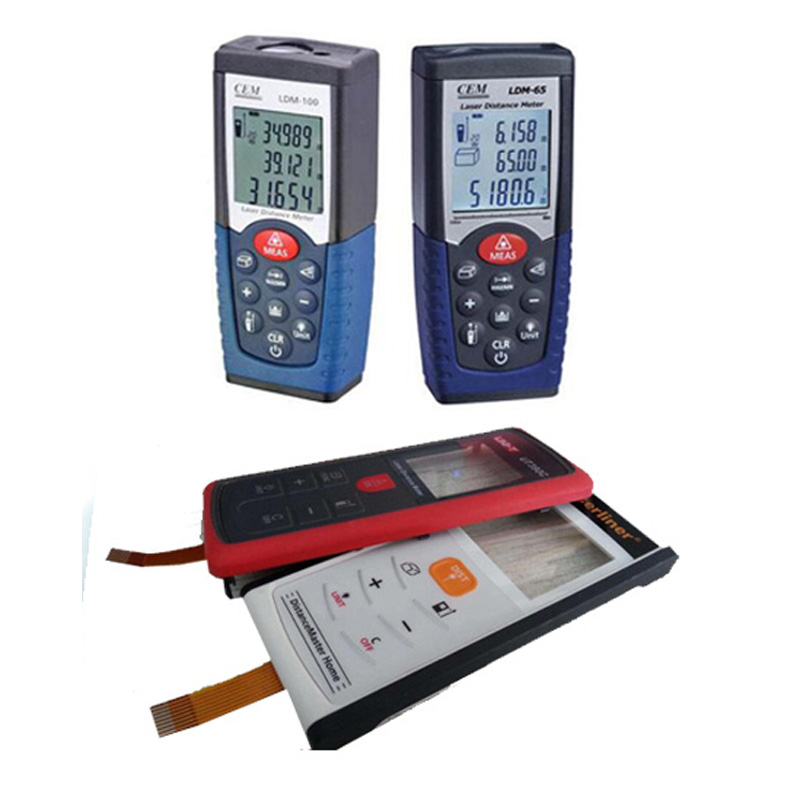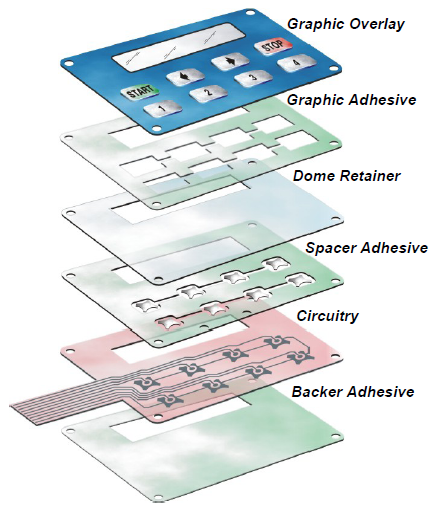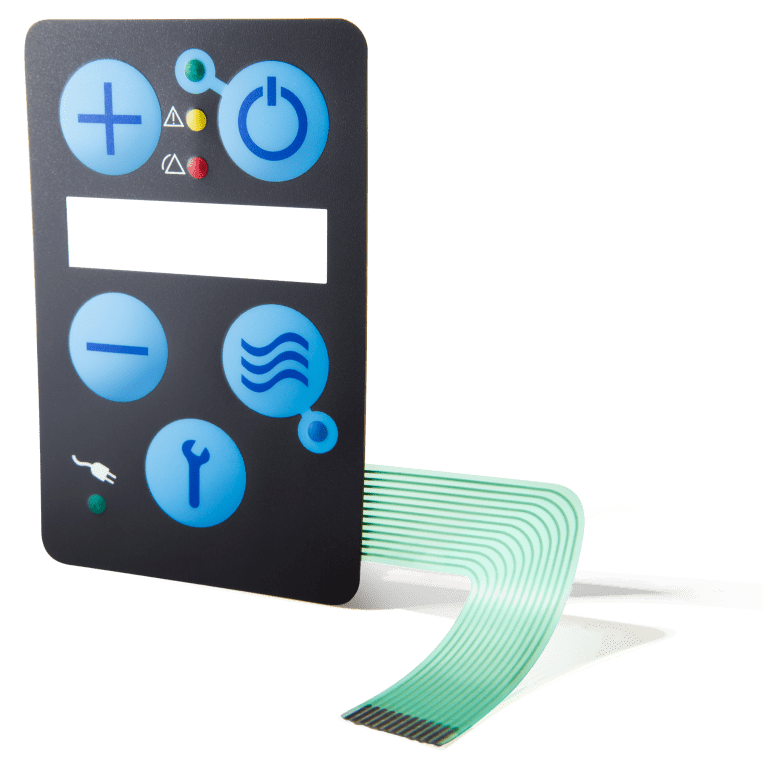Membrane switch and aesthetics: How to align function with form
The Production Refine Behind Membrane Switch Over: What You Need to Know
The manufacturing procedure behind membrane switches combines cautious design, product selection, and quality assurance. It starts with understanding the details of membrane switch design and advances through various phases, including product selections and printing strategies. Each stage plays a vital function in making sure performance and sturdiness. Nevertheless, the complexities of layer building and construction and the rigorous screening criteria might expose insights that are not quickly apparent. What lies beyond these foundational elements?
Comprehending Membrane Layer Switch Layout
Membrane layer buttons might appear simple at first look, their layout includes detailed factors to consider that assure capability and longevity. The design procedure starts with an extensive understanding of customer requirements, including the interface's desired application and ecological elements. Functional designs is a vital aspect, as the design has to facilitate ease of use while making sure that responsive responses meets user expectations.Moreover, the layering of components, such as graphic overlays, glue layers, and conductive traces, have to be specifically crafted. membrane switch. This split configuration not just affects the switch's responsiveness however likewise influences its longevity. Focus is offered to the securing techniques used to protect versus dampness and dust, which can endanger efficiency. Furthermore, style considerations include looks, where color plans and visual quality boost customer experience. Inevitably, the style of membrane layer switches over balances capability, customer experience, and durability, guaranteeing that they satisfy the demands of various applications efficiently
Products Used in Membrane Switch Over Production
When picking materials for membrane button manufacturing, it is necessary to consider both efficiency and durability. The key materials consist of polyester and polycarbonate movies, which offer versatility and strength. These movies are typically covered with sticky to ensure proper bonding to substrates. Conductive inks, typically made up of silver or carbon, are vital for producing electrical connections within the switch, enabling dependable operation.Additionally, a safety layer, such as a hard coat, is often put on enhance scrape resistance and longevity. The option of backing material, such as acrylic or foam, can significantly affect the button's tactile feel and overall customer experience. In addition, different ecological factors, consisting of temperature and moisture, need to assist product selection to ensure peak performance in certain applications. Ultimately, the right combination of products contributes to the membrane button's capability and life-span, making notified selections crucial for makers.
The Printing Refine: Creating Video and Text
The printing procedure in membrane layer button manufacturing plays a substantial role in producing premium graphics and text. Numerous graphic design strategies are used to guarantee aesthetic allure and performance, while cautious ink choice approaches are necessary for resilience and performance. Understanding these aspects is essential for accomplishing ideal lead to membrane switch layout.
Graphic Layout Techniques
Graphic style techniques play a necessary role in the printing procedure of membrane layer buttons, as they define just how graphics and message will ultimately appear on the final product. Reliable graphic style entails the calculated usage of formats, colors, and font styles to enhance readability and aesthetic allure. Developers often make use of vector graphics for scalability, ensuring that pictures remain sharp at numerous sizes. Furthermore, attention to comparison and positioning is important, as it affects customer communication and aesthetic top quality. The incorporation of branding components, such as logo designs, have to be managed with like preserve brand name stability. On the whole, thoughtful visuals layout methods contribute considerably to the performance and appearance of membrane buttons, influencing individual experience and product performance.
Ink Option Methods
Choosing the suitable ink is vital for accomplishing the wanted aesthetic high quality and resilience in membrane layer button manufacturing. Different ink kinds are utilized, including solvent-based, water-based, and UV-curable inks. Each kind uses unique features, such as adhesion, resistance, and flexibility to ecological factors. Solvent-based inks are commonly preferred for their toughness and vivid shades, while water-based inks are more ecologically friendly however may have restrictions in bond. UV-curable inks offer fast treating and robust performance. In addition, color matching strategies ensure that the selected inks straighten with style specs. Eventually, the choice of ink have to think about factors such as application approach, substrate compatibility, and end-use demands to achieve remarkable cause membrane layer switch graphics and message.
Layer Building and Assembly

Product Selection Refine
A cautious choice of materials is essential in the manufacturing procedure of membrane switches, as it directly affects functionality and sturdiness. The primary products made use of include polyester, polycarbonate, and numerous conductive inks. Polyester is commonly preferred for its exceptional resistance to chemicals and abrasion, making it ideal for rough atmospheres. Polycarbonate, on the other hand, offers premium clearness and impact resistance, which is valuable for applications requiring presence and robustness. Conductive inks, usually made up of silver or carbon, are crucial for developing reliable electric paths. Furthermore, the choice of sticky materials influences the general integrity of the switch - membrane switch. Evaluating variables such as ecological exposure, responsive comments, and aesthetic demands guides manufacturers in choosing the very best materials for their certain applications
Layer Attachment Strategies
Sticking layers in membrane layer button construction is an essential process that ensures functionality and durability. Different attachment techniques are utilized to secure ideal bonding between layers, which normally include the use of adhesives, warm, and pressure. Pressure-sensitive adhesives (PSAs) are typically made use of for their simplicity of application and prompt bonding capabilities. Furthermore, thermal bonding methods can be used, where warmth is utilized to turn on glue properties, securing a strong bond. The option of adhesion technique mainly depends upon the materials involved and the details application demands of the membrane layer switch. Appropriate alignment and consistent application of adhesives are vital to avoid issues, safeguarding the button operates effectively throughout its intended lifespan.
Quality Control Measures
Guaranteeing high quality control during the layer construction and assembly of membrane layer buttons is vital for preserving performance and dependability. This process generally entails a number of crucial measures, consisting of complete evaluations at each phase of manufacturing. Suppliers use advanced screening methods, such as peel examinations and adhesion assessments, to validate the integrity of layer bonds. Furthermore, aesthetic assessments are carried out to recognize any defects in printing or product disparities. Ecological problems, such as temperature level and humidity, are very carefully monitored to assure optimal curing and attachment. Normal calibration of devices helps preserve exact production standards. By implementing these quality control steps, makers can significantly minimize the danger of item failure, ensuring that the last membrane switches over satisfy the required requirements and client expectations.
Testing and Quality Assurance Steps

Developments in Membrane Layer Switch Over Technology
As innovations in technology remain to progress, membrane layer switches are taking advantage of cutting-edge developments that enhance their capability and individual experience. One notable technology is the combination of capacitive touch technology, which permits even more receptive and intuitive customer interfaces. This change not just improves looks yet additionally reduces mechanical deterioration, expanding the lifespan of the switches.Additionally, advancements in graphic overlay materials have actually led to enhanced longevity and resistance to environmental factors such as dampness and UV light. These materials currently use enhanced clearness and brightness, more elevating the visual appeal.Furthermore, the incorporation of clever modern technology is transforming membrane switches into interactive control panels, making it possible for connectivity with IoT gadgets. This connection cultivates a seamless individual experience, leading the way for applications in various markets, from medical care to customer electronics. Collectively, these technologies position membrane switches over as essential components in modern-day tool design.
Regularly Asked Questions
Exactly how Long Does the Membrane Layer Change Production Refine Take?
The period of the membrane layer button production process can vary significantly. Variables such as intricacy, products made use of, and manufacturing quantity impact timelines, with normal manufacturing varying from a couple of days to a number of weeks for completion.
What Are the Typical Applications for Membrane Buttons?
Membrane switches are generally used in various industries, consisting of automobile controls, household devices, medical tools, and customer electronics (membrane switch). Their convenience and longevity make them suitable for applications requiring easy to use interfaces and dependable performance in varied atmospheres
Can Membrane Switches Be Custom-made for Details Requirements?

What Is the Life-span of a Typical Membrane Switch?
The life expectancy of a normal membrane layer button differs, yet generally, it ranges from 1 to 5 million cycles. Factors such as usage, environment, and material quality significantly influence sturdiness and general efficiency gradually.

Are Membrane Layer Switches Over Eco-friendly?
The environmental friendliness of membrane layer switches over differs. Some materials used might not be recyclable, while others can be green. The total effect depends on manufacturing techniques and products, demanding cautious consideration throughout choice and disposal. The manufacturing process behind membrane layer changes combines careful layout, material selection, and top quality control. It begins with understanding the details of membrane button style and progresses via different stages, consisting of material selections and printing methods. When selecting products for membrane button manufacturing, it is essential to consider both performance and longevity. A cautious selection of products is important in the try this site production process of membrane layer switches, as it straight influences performance and resilience. The selection of adhesion approach largely depends on the products involved and the certain application requirements of the membrane button.